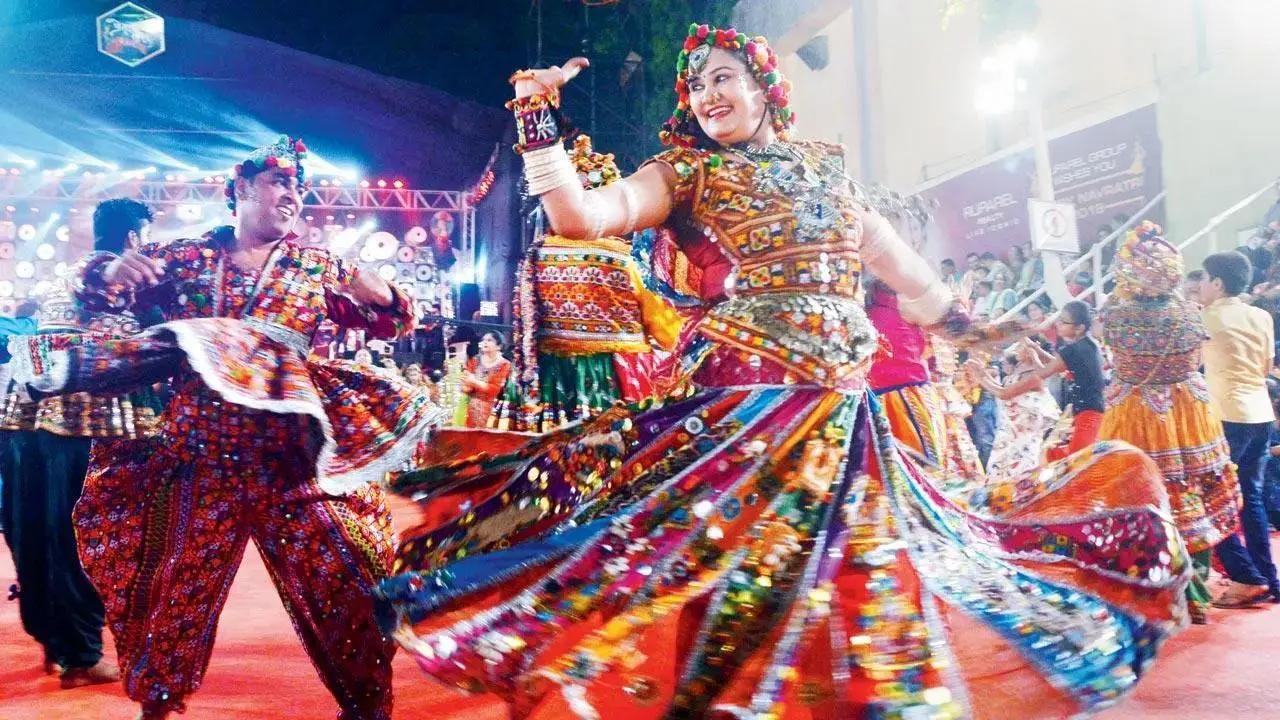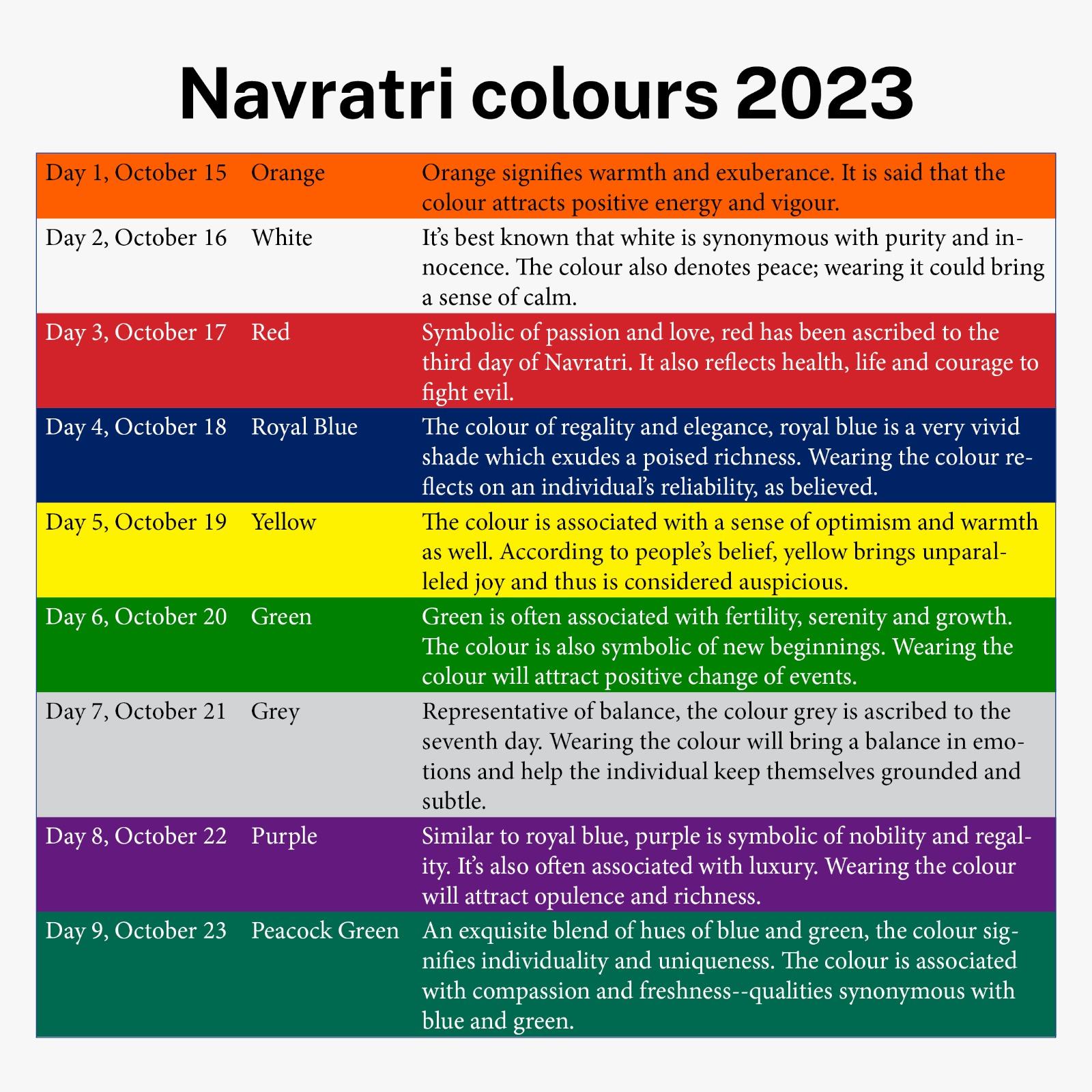Besides Holi, Navratri can also be called the festival of colours. Women, especially, wear a variety of nine vibrant colours during this nine-day-long festival and offer their prayers to Indian goddesses. For Shardiya Navratri 2023, we share the released colour schedule for you to follow during the festival

File Pic/Sayyed Sameer Abedi
Navratri is celebrated with much fervour in India, especially in Bengal, Gujarat and Maharashtra etc. Alongside the religious events, the devotees revel in the celebrations by playing Garba or Dandiya raas. Navratri, which is also called Shardiya Navratri, is a festival which is symbolic of the triumph of good over evil. During the nine days of festivities, devotees worship different forms of Goddess Durga. This year, October 15 marks the beginning of Shardiya Navratri 2023 and the auspicious festival will come to an end on October 24 with Dussehra.
ADVERTISEMENT
What is Shardiya Navratri?
The festival is dedicated to worshipping the divine Indian goddess Durga and her nine avatars - Navdurga. As the name of the festival goes, Navratri in Sanskrit stands for nine nights: ‘Nav’ means nine and ‘ratri’, nights.
Chaitra Navaratri and Shardiya Navratri are celebrated on a large scale. The festival is celebrated across the country with each region having its own customs, traditions and ways of celebration.
Also Read: Navratri 2023: Flaunt your Garba moves in style with these outfit ideas
History
Navratri celebrates the killing of the demon Mahishasura and the victory of good over evil.
As per Hindu legends, Mahishasura was blessed and gifted with immortality by Lord Brahma because of his immense dedication to him. However, this blessing came with one condition — the only person who would be able to defeat him would be a woman.
Mahishasura didn't believe so. He was confident that no woman would be powerful enough to defeat him. The demon soon began misusing the power that terrorised people on Earth. Not even the most powerful gods succeeded in stopping him.
As a way to put an end to this, the trio, Lord Brahma, Lord Vishnu and Lord Shiva combined their energies and created the goddess Durga and equipped her with several powers and weapons.
A battle between goddess Durga and demon Mahishasura lasted 10 days and the goddess successfully defeated him.
Following this legend, India celebrates Navrati which signifies the strength of women.

Also Read: Ratalu to Roesti: Mumbai chefs share gluten-free Navratri fasting recipes
Celebrations
During the nine days of the festival, devotees worship the different avatars of the goddess Durga and seek her blessings. Each day is dedicated to one avatar. Many also observe ritualistic fasts, recite prayers dedicated to each goddess, dress well by wearing new clothes, offer bhog (meal inclusive of various dishes), and play garba and dandiya raas.
Relevance of nine colours
The festivities acquire an element of fun as all nine days are ascribed a colour and it is believed that wearing outfits in accordance with the same is auspicious. This year, the colours include royal blue, peacock green and etc. The list of these colours is referred to widely. Moreover, each colour signifies a virtue. Check out the complete list of colours to be worn this Navratri:
Day 1, October 15 - Orange: Orange signifies warmth and exuberance. It is said that the colour attracts positive energy and vigour.
Day 2, October 16 - White: It's best known that white is synonymous with purity and innocence. The colour also denotes peace; wearing it could bring a sense of calm.
Day 3, October 17 - Red: Symbolic of passion and love, red has been ascribed to the third day of Navratri. It also reflects health, life and courage to fight evil.
Day 4, October 18 - Royal Blue: The colour of regality and elegance, royal blue is a very vivid shade which exudes a poised richness. Wearing the colour reflects on an individual's reliability, as believed.
Day 5, October 19 - Yellow: The colour is associated with a sense of optimism and warmth as well. According to people's belief, yellow brings unparalleled joy and thus is considered auspicious.
Day 6, October 20 - Green: Green is often associated with fertility, serenity and growth. The colour is also symbolic of new beginnings. Wearing the colour will attract positive change of events.
Day 7, October 21 - Grey: Representative of balance, the colour grey is ascribed to the seventh day. Wearing the colour will bring a balance in emotions and help the individual keep themselves grounded and subtle.
Day 8, October 22 - Purple: Similar to royal blue, purple is symbolic of nobility and regality. It's also often associated with luxury. Wearing the colour will attract opulence and richness.
Day 9, October 23 - Peacock Green: An exquisite blend of hues of blue and green, the colour signifies individuality and uniqueness. The colour is associated with compassion and freshness--qualities synonymous with blue and green.
 Subscribe today by clicking the link and stay updated with the latest news!" Click here!
Subscribe today by clicking the link and stay updated with the latest news!" Click here!












